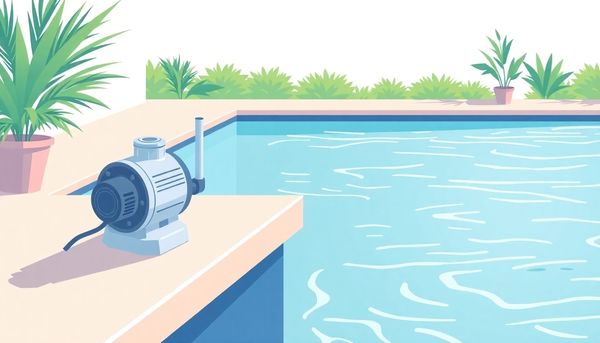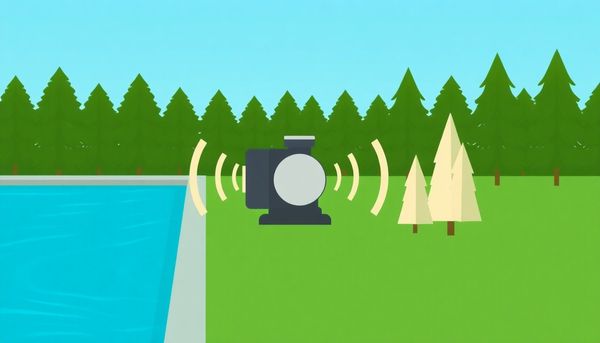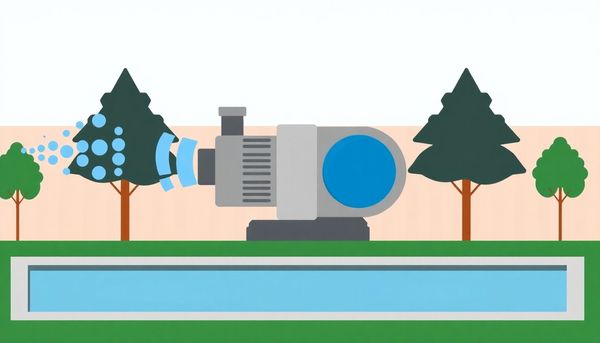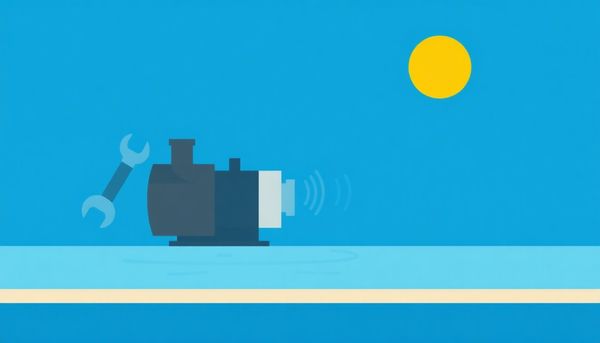Silence Your Noisy Pool Pump: Easy DIY Fixes for a Peaceful Backyard
July 03th, 2024
July 03th, 2024
The serenity of a backyard oasis can be easily shattered by the incessant clatter of a noisy pool pump. Rather than a soothing retreat, the poolside can become an unwelcome source of stress. I've been there myself, sipping coffee on a sunny morning only to be interrupted by the harsh grind of machinery. It’s not just an annoyance; it's a call to action.
These sounds are often more than just a nuisance—they could be signaling mechanical issues or inefficiencies lurking beneath the water's surface. A loud pool pump isn’t merely an auditory disturbance; it hints at underlying problems that could escalate if ignored. My own experience with a rattling pump taught me the importance of timely intervention. The solution wasn’t just about silencing the noise; it was about understanding the cause.
Exploring the reasons behind a noisy pump can seem overwhelming, especially when technical jargon adds to the confusion. However, with a clear approach, these challenges can be navigated with ease. In this guide, we’ll uncover practical tips that not only address the noise but also enhance the longevity of your equipment. From checking for debris to ensuring proper installation, each step holds the key to restoring peace. Let’s embark on this journey to transform that chaotic hum into a gentle whisper, befitting a tranquil escape.

Every backyard pool owner cherishes those quiet moments by the water, but a noisy pump can disrupt this tranquility. When the familiar hum turns into a disruptive rattle or screech, it’s time to play detective. Each sound hints at a different culprit, and understanding these audio clues can save you both time and headaches.
Consider your pump's surroundings. Often, an overlooked cause of noise is the pump’s placement. If it rests on an uneven surface or a poorly constructed pad, vibrations can amplify. Use rubber pads or vibration-dampening materials beneath the pump's base to absorb sound and stabilize it. This simple adjustment can transform your pump from a clatterbox to a whispering machine.
Inspect the pump's housing for loose or cracked components. Over time, exposure to the elements and continual use can loosen bolts or create cracks, resulting in a cacophony of rattles. A thorough examination might reveal a loose housing or missing screws, which are easily tightened or replaced.
Bearings can also be the silent saboteurs of poolside peace. When they age, they can cause an unbearable squeal. If you suspect the bearings, it may be time for a replacement. While this is a bit more complex, involving a bit of technical know-how, ensuring smooth bearings will keep your pump running quietly and efficiently.
Lastly, recall my own misadventure: a curious small stone lodged within the impeller once drove me mad with noise. A quick disassembly and removal of the offending pebble restored harmony. Sometimes, the solution is right under your nose—or, in this case, inside the pump!
When the heart of your pool's circulation starts growling or whirring at odd times, it’s like your pump is speaking a language you don’t quite understand. Noise is often the pump's way of waving a red flag, hinting at motor issues that need urgent attention. First, consider your pump's electrical source. An old friend once taught me the 'breaker dance'—turning the breaker off and on again. You'd be amazed at how many problems a simple reset can solve.
Next, delve deeper into the guts of the pump: the impeller. This unsung hero spins tirelessly to keep your pool water in motion. When jammed, the motor can transform into a source of alarming sounds. A careful exploration using a bent wire hanger might reveal debris lodged within. It's a task I’ve tackled many times, armed with a flashlight and a dose of patience. Clearing out the impeller can restore much-needed peace.
Then, there’s the unconventional yet surprisingly effective tactic—reviving the motor’s spirit with a well-placed thump from a rubber-soled shoe. It’s like hitting the TV set when the picture goes fuzzy; a quick impact can sometimes jolt the motor into action. Yet, this is more of a temporary bandaid, hinting at deeper issues like failing bearings. If the noise persists, remember, a persistent roar often signals it’s time to call in the pros or consider a new motor. Addressing these issues not only silences the noise but ensures your pool remains a tranquil haven.
The heart of your pool pump is its impeller—a small component with a mighty job. If you've ever dealt with a pump that hums like an agitated bumblebee or roars like a jet engine, your impeller might be the silent troublemaker behind it all. This tiny whirl of plastic or metal tirelessly spins to propel water through the system. However, when debris sneaks past the pump basket or algae builds up over time, the impeller can jam, causing your pump to emit those unsettling noises.
Begin by shutting off the pump at the breaker to avoid any electrical mishaps. Remove the pump basket, and with a cautious hand, feel your way to the impeller located towards the back. Imagine reaching into your cluttered kitchen drawer for a spoon – a similar adventure minus the cutlery! Use a screwdriver or a bent wire hanger if you need help nudging the impeller into motion. This gentle coaxing often frees any trapped debris, allowing it to spin freely once more.
A personal tale might help illustrate this: last summer, a particularly stubborn leaf wedged itself in my pump's impeller. A quick disassembly and a bit of patient prodding resolved the issue, transforming the pump's roar into a soothing hum. Addressing impeller issues can be surprisingly straightforward, saving you from unnecessary expenses and keeping your poolside gatherings serenely splash-filled.
Tuning into the symphony of your backyard, a pool pump’s rhythm should be a gentle background hum, not a deafening roar reminiscent of a jet engine. When the melody is off, the culprit might just be water-flow hiccups. One morning, I discovered my pool pump was more cacophony than sonata, and the reason lay in an unexpected place: the water flow.
Start by checking the water level in your pool. If it’s too low, the pump might be gasping for air, causing it to struggle and whine. A simple top-up with your garden hose can often restore the harmony. When the water dances just right into the skimmer, the pump breathes easy, and its song becomes sweet again.
Clogs are another frequent offender in disrupting this flow. Leaves, debris, or even a cheeky toy can lodge themselves in the skimmer basket or pool pump strainer. Regularly clearing these obstructions can prevent your pump from straining and producing unwelcome noises. Think of it as a spa day for your pump – a little care goes a long way.
Priming the pump, akin to giving it a refreshing drink, may also be necessary. After all, no matter how well-oiled the machine, it requires the right balance of water to keep its tune. In this way, addressing water-flow issues doesn’t just silence your pump but ensures it performs with a flourish.

Humming motors in pool pumps often signal trouble, but before you rush to call in the cavalry, there are a few practical steps to consider. When I faced this issue with my own pool pump, the sound was eerie, like a bee trapped in a jar. It turned out the motor was struggling to start up, and here's how I tackled it.
First, head to your electrical breaker. Sometimes, a simple reset can work wonders. Switching it off and on again could unjam the circuit, offering a quick fix. If that doesn't do the trick, it's time to get your hands a bit dirty. The impeller—often the unsung hero of your pump's mechanism—can be the guilty party. When it jams, the motor can't operate as it should. Power down the pump at the breaker and remove the basket. With a little courage, reach into the pump housing. A friend of mine once used a bent wire hanger to carefully spin the impeller manually, and it worked like a charm.
In some cases, a gentle tap with a rubber mallet or even a shoe can nudge a stubborn motor back to life. Think of it as giving the pump a wake-up call, but approach with caution to avoid any added damage. This method, though oddly effective, might signal it's time to start budgeting for a motor replacement soon. Each of these steps can potentially save you from costly repairs, blending a bit of DIY spirit with practical problem-solving.
Sometimes, resetting the breaker is all it takes to quiet that noisy pool pump. When your pump begins to hum or produces an incessant racket, it could be a sign of an electrical hiccup. Start by locating the electrical breaker that powers your pool pump. This is usually found in your home's breaker box, often labeled for easy identification. With a flick of the switch, you can cut the power to the pump momentarily. Once you’ve allowed a few moments for the system to rest, switch it back on. This simple action can reset the electrical current and might just restore peace to your backyard oasis.
I recall a time when my own pool pump decided to kick up a fuss in the middle of a family barbecue. The noise was so persistent that it nearly drowned out our conversations. Remembering this trick, I excused myself, found the breaker, and with a hopeful heart, reset it. To my delight, the relentless humming ceased, and the only sound left was the comforting splash of water.
Apart from silencing the pump, resetting the breaker can also protect it from further damage. A pump that’s struggling to function due to a tripped breaker might overheat or cause additional wear and tear on its components. So, before reaching for your phone to call in a costly professional, give resetting a try. In many cases, this quick fix can save not only your hearing but also your wallet.
Ever been near a pool pump that sounds more like a jet engine than a serene water feature? One likely culprit is a stubborn impeller. This small yet mighty component is the heart of your pump, drawing water into the system and pushing it through the filter. A misbehaving impeller can transform your peaceful backyard into a cacophony of disgruntled noise.
Start by ensuring the pump is switched off at the breaker—safety first. Once you’ve removed the pump basket, reach inside to locate the impeller. It often lurks towards the back, waiting to be freed from debris or any small objects that might have wedged themselves in. A handy trick is using a bent wire hanger or a screwdriver to help gently coax the impeller into motion. It’s like finding that sneaky Lego piece hidden under the sofa; a little persistence goes a long way.
After clearing and spinning the impeller manually, power the pump back on. The harmonious hum of a properly functioning pump is music to the ears. If the problem persists, it might be worth considering a deeper clean or seeking out more professional advice. Yet, often, this simple hands-on approach can save you time and money, leaving you more moments to enjoy your pool in peace.
Sometimes the simplest solutions might seem a bit unorthodox, yet they hold a certain charm. Ever considered giving your pool pump a gentle tap with a shoe? It’s an age-old trick akin to coaxing an old TV set back to life by tapping the side. This method harnesses the power of mechanical jostling to dislodge any stubborn particles or to nudge a stuck component back into place.
Before you channel your inner mechanic, ensure you're proceeding with caution. Safety first: switch off the pump at the breaker to prevent any electrical mishaps. Once that's done, don your trusty rubber-soled shoe or grab a rubber mallet. These tools are your allies—delivering just enough force to potentially free any jammed parts without causing damage. When the pump attempts to start, a couple of measured taps can sometimes kick it back into action.
It's a bit like giving a hearty pat on the back to an old friend who's just caught in a coughing fit. But remember, while this method can breathe temporary life into your pump, it could also be a sign that more significant repairs are looming. If your pump responds to this method, it’s crucial to follow up with a thorough check-up. Dive into the possibility of wear and tear in the motor components to prevent a repeat scenario. Just like any relationship, a little attention and care go a long way in ensuring longevity.

When the sound of a squealing pool pump pierces the tranquility of your backyard oasis, it’s a call to action. That high-pitched noise often signals trouble with the pump's bearings. Bearings, the unsung heroes of the pump, allow smooth rotation. Yet, like any overworked component, they can wear out, especially if exposed to elements like chlorinated water.
First, unplug the pump to ensure safety—wet environments and electricity are a hazardous mix. Next, remove the pump housing to access the bearings. This step may require a bit of elbow grease, so be prepared with a wrench or screwdriver. Once inside, inspect the bearings. If they're corroded or visibly damaged, replacement is the best solution. Most hardware stores carry these parts, and swapping them out can be a straightforward task.
However, if you're not ready to tackle replacement, there's a temporary fix. Lubrication can often quell the squeal, albeit briefly. Apply a suitable lubricant directly onto the bearings. This won’t reverse any damage but can reduce the noise while you schedule a proper repair. Remember, these stopgap measures are just that—temporary. Prolonged use of failing components can lead to more severe damage, often resulting in a pricier fix down the line. By addressing the issue early, you maintain the pump’s efficiency, ensuring your pool stays ready for those sun-soaked afternoons.
Sometimes, the sound of a pool pump can be akin to a symphony gone wrong, especially when it’s the motor in distress. A humming noise often signals that your pump’s motor is experiencing trouble. To begin tackling this issue, first consider the obvious: the electrical breaker. The breaker might have tripped, causing the motor to falter. Simply resetting it can often bring peace to your mechanical orchestra.
Moving beyond the breaker, let's focus on the impeller. Think of the impeller as the heart of your pump, tirelessly pushing water through the system. When jammed, it can lead to motor seizure. To remedy this, ensure the pump is off at the breaker, open the pump basket, and manually check the impeller. If you're not sure where to find it, a gentle exploration with a bent wire hanger will help locate and free any obstructions. This manual spin might just be the kick-start your impeller needs.
If all else fails, there's a rather unconventional, yet surprisingly effective, method: firmly tapping the pump motor with a rubber mallet or a rubber-soled shoe. This might sound odd, but the vibration can sometimes jiggle things back into place temporarily. A word of caution, though—this approach might indicate deeper, impending motor issues. A temporary fix won’t hold forever. Regular maintenance, as any pool owner will tell you, is key to keeping your pump whispering sweet nothings instead of screeching complaints.
A pool pump can sometimes sound like it's auditioning for a role in a horror movie. When it starts making unsettling noises, addressing water-flow issues might just be your ticket to peace and quiet. Picture your pool as a symphony, with each component playing its part in harmony. Now, imagine if the flutist suddenly goes rogue. What happens? Chaos and discord. The same occurs when your pump isn’t receiving adequate water.
First, glance over at the water level. It should be at least halfway up the skimmer opening. If it's lower, your pump might be sucking in air instead of water, creating a gurgling or screeching sound. This air invasion throws the pump’s rhythm off balance. Simply topping up the pool can often alleviate the noise.
Then, consider priming the pump. This involves filling the pump housing with water to help it start moving water efficiently again. A trusty garden hose can be your best friend here. Gently add water until the pump housing is full, then switch the pump back on and observe. If the chaotic noises subside, you’ve likely resolved an airlock issue.
Keep in mind, debris can also block water flow. Check the pump basket and filter for any obstructions that might be impeding progress. Clear these away, and let the water flow freely, restoring tranquility to your backyard oasis. Your pump’s once ominous soundtrack can return to a gentle, soothing hum.
When it comes to taming a noisy pool pump, unconventional methods like impact techniques might just be the unsung heroes. However, it's not simply about whacking your pump with brute force. The key lies in employing these techniques wisely and with precision.
Imagine you're at the edge of your pool, pump humming angrily. A gentle tap with a rubber mallet — or even a rubber-soled sneaker — can sometimes provide just the nudge needed to dislodge a misaligned component within the motor. This isn't a remedy to wield recklessly. Ensure your tool of choice has a forgiving surface to prevent cracking or otherwise damaging the pump housing. Hitting the motor precisely as it powers on might just coax it back into a smooth rhythm, but timing and finesse are crucial. Think of it as a delicate nudge rather than a forceful blow.
Though tempting to rely solely on this quick fix, remember it's a temporary solution that hints at deeper issues. Frequent reliance on impact techniques could signal impending motor failure, a sign that more permanent repairs or replacements are on the horizon. In my own experience, a friend once transformed a raucous pump into a purring machine with a few strategic taps, buying precious time until a more comprehensive repair. Use this technique sparingly, respecting its power and limitations, and you'll extend the life of your pool pump without venturing into the realm of accidental destruction.

Resurrecting your pool pump with a little DIY prowess can feel like unraveling a mystery. Many times, the pump's noisy complaints are cries for simple adjustments, not a full-blown professional intervention. Once, in the heat of summer, I faced a similar predicament. My pool pump sounded like it was auditioning for a heavy metal band. Instead of panicking, I decided to channel my inner detective.
Begin by inspecting the pump’s impeller for blockages. This small component spins to move water and can be surprisingly stubborn if jammed. After switching off the power, reach inside the pump housing cautiously, perhaps with the aid of a screwdriver or the ingenuity of a bent wire hanger. Even a minor twig can wreak havoc, so ensure it's clear before giving the impeller a gentle spin.
Next, the infamous motor rap trick: a rubber-soled shoe or mallet is your trusty sidekick here. As the pump attempts to start, a few well-placed taps can coax it back to life. My initial skepticism faded when this actually worked, though I knew it was a temporary fix signaling the need for a future motor check-up.
Water flow also plays a crucial role. A gurgling echo might mean your pump is thirsty. Ensuring the pool's water is at the proper level and priming the pump with a garden hose can often resolve the issue. With these steps, you might just find your pool pump purring rather than roaring, all thanks to a bit of personal elbow grease.
A pool pump purring smoothly is music to any pool owner's ears, but when it starts sounding like a high school marching band warming up, attention is needed. In particular, the motor often becomes the culprit behind those loud, unsettling noises. Imagine waking up on a Saturday morning, ready for a refreshing swim, only to be greeted by an obnoxious hum or worse, a screech that rivals nails on a chalkboard. This nerve-jangling cacophony could signal a motor issue, but before frustrations rise higher than your water bill, consider a few hands-on solutions.
Start by checking the electrical breaker. Sometimes, the simplest step—switching it off and back on—can reset minor disruptions. Next, get your hands a little dirty. After ensuring the breaker is off, inspect the impeller. This crucial component can often become jammed, causing the motor to struggle. Remove the pump basket and manually spin it; sometimes, a simple twist is all it takes to dislodge debris that’s bringing your pool party to a halt.
Now, here's where it gets interesting. If the motor is still acting up, a little unconventional therapy might be in order. Arm yourself with a rubber mallet or even a trusty shoe, and gently tap the motor as it attempts to start. While this might seem a tad primitive, it's a surprisingly effective trick to kickstart stubborn motors. Just make sure to wield your makeshift tool with care to avoid further damage. If the problem persists, though, it might be time to acknowledge that a motor replacement is inevitable. After all, even the best stories sometimes call for a new chapter.
Ever heard the unsettling growl of a jammed pool pump? When the impeller—the heart of your pump—gets stuck, it’s like having a clogged artery in your pool’s circulation system. This is a common culprit if you hear a persistent humming but see no water flow. To tackle this issue, first, ensure safety by switching off the breaker. This is not just a step; it's a necessity when dealing with any pool equipment.
Once the power is off, remove the pump basket to gain access to the impeller. Have you ever untangled a necklace chain? It's a bit like that, only with water gunk and debris. Reach into the pump housing with your hand, or if you're feeling hesitant, employ a trusty tool like a bent wire hanger or a screwdriver. Gingerly clear out any debris wrapped around the impeller blades, ensuring nothing obstructs its movement.
Then comes the moment of truth: manually spin the impeller to ensure it's free and willing to move. Power the pump back on, and if all goes well, the water should flow like music to your ears. This simple DIY method doesn’t just restore function; it saves you the expense of a professional call-out. Remember, regular checks can prevent future jams, keeping your pool’s heart healthy and your water sparkling clean.
A pool pump making a racket isn't just annoying; it might signal an issue with water flow. Start by ensuring the pool’s water level is at least halfway up the skimmer. If the water level drops too low, air can sneak into the system, creating that irritating gurgling. I remember a time when I was puzzled by a similar noise; a quick check showed that evaporation had quietly lowered the water level.
Beyond the basics of water level, it’s crucial to inspect the skimmer and pump basket for debris. Leaves, twigs, or even an unexpected frog can obstruct flow, leading to unwanted sounds. Once, during a routine check, I found a small toy lodged in the basket—proof that kids and pools can lead to unusual discoveries. Removing blockages not only silences the pump but also extends its life.
Another angle to explore is the pool's valves. Make sure they’re set correctly to allow optimal water circulation. Incorrect valve settings can hinder flow, putting unnecessary strain on the pump and creating noise. Finally, consider the pipe size of the pump. Too narrow and it restricts flow, causing the motor to work harder and louder. Consulting your pump’s manual can offer insights here, ensuring everything from pipe size to valve positioning is just right for peace and quiet in your backyard oasis.

Water flow is the lifeblood of any pool system, and disruptions here can transform tranquility into turmoil. When your pool pump sounds more like a gurgling drain than a well-oiled machine, it's time to roll up your sleeves and investigate. Start by checking if the water level in your pool is at least halfway up the skimmer. This might seem basic, but low water can cause air to enter the system, leading to those distressing noises.
Blocked pipes are another sneaky culprit. Fallen leaves or debris can find their way into the skimmer basket or pump strainer, choking the flow. Don your detective hat and clear out these obstructions. You might find it's just a simple blockage that was causing all that racket. Once cleared, the water should glide smoothly through the system, and the noise should subside.
But let's not stop there. Examine the pump's impeller, especially if the pump still howls despite a clean skimmer. A clogged impeller can mimic similar symptoms, and accessing it might require a bit of disassembly. Use a flashlight and a thin object like a coat hanger to gently dislodge any debris. By addressing these potential flow issues, you not only silence the pump but also ensure efficient circulation, keeping your pool sparkling and serene. With a little patience and elbow grease, your oasis of calm will be restored.
Ever had a pool day interrupted by a relentless hum emanating from your pool pump? That sound often indicates a motor issue that's begging for your attention. So, before you dial up your pool guy, let’s explore a few DIY solutions that might just save you some cash and keep your poolside tranquility intact.
To begin with, examine the simple fix: the electrical breaker. It’s not uncommon for power issues to masquerade as mechanical failures. Locate the breaker that governs your pump, switch it off, then back on. This quick reset might be all it needs to shake off a tripped circuit.
Next, turn your attention to the impeller, the real workhorse in your pump’s setup. If the impeller’s jammed, the motor will hum its discontent. With the power off, take out the pump basket and reach inside the pump housing. Feel around for the impeller, using a screwdriver or a bent wire hanger to gently nudge it. Clear any obstructions and attempt a restart.
Lastly, channel your inner DIY enthusiast with a quirky yet effective trick: the rubber mallet tap. As unconventional as it sounds, using a rubber-soled shoe or a mallet to lightly tap the motor while powering it on can occasionally jolt it back into action. Be gentle, though—think of it more as a nudge than a karate chop.
There is a caveat to this quick fix. Although it might buy you some time, frequent humming is a red flag for motor health, suggesting a future replacement is inevitable. But for now, enjoy the silence and your well-deserved swim.
Ever felt like your pool pump is auditioning for a role in a heavy metal band? That racket might be more than just bothersome—it's often a cry for help from a blocked impeller. The impeller is crucial for your pump’s operation, as it spins rapidly to move water through the system. When it stumbles upon debris, your pump might sound like it's chewing gravel.
Before you panic, consider this: clearing a blockage is often a straightforward task. Start by cutting power to the pump at the breaker. Safety first—water and electricity are a dangerous duo. Once that's sorted, remove the pump basket. You might find the culprit right there—leaves, twigs, or other assorted debris longing for pool party invitations.
Now, let’s get tactile. Reach into the pump housing where the impeller resides. It may feel like fishing out that last pickle from the jar, but persistence is key. Use a screwdriver or a bent wire hanger to gently coax out any stubborn bits lodged within. Be patient and thorough—rushing this step could lead to a more stubborn blockage down the road.
Once cleared, reassemble everything, power up the system, and listen. With any luck, the clamor will have died down, leaving only the soothing hum of a well-functioning pump. This simple maintenance could extend the life of your pump and keep your neighbors from lodging noise complaints.

This article provided insights into maintaining your pool. Start your pool care journey today!
Want to become a pool maintenance expert? Our free Pool School course covers everything you need to know about pool care. From basic maintenance to advanced troubleshooting, you'll learn how to:
Join over 10,000 pool owners who have already transformed their pool care routine. Get started with our free Pool School course today!